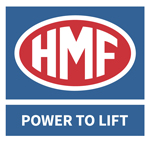With the release of the new HMF “RCS” range of high performance cranes, it’s a good to remember that the well proven EVS system is still available, and on larger and lighter weight cranes, it adds more to the versatility of the crane.
EVS, or Electronic Vehicle Stability system has been available for some time, and is well proven in the field. So what does it do, and why do you need it?
First a bit of background.
Every modern knuckle boom crane (above a 1TM rated capacity) has a computer controlled safety system. This system is set at the factory, or following installation by a qualified crane programmer. This program tells the crane what it can lift where, and determines the cranes basic safe working capacity. The basic system requires that the stabiliser legs are all the way out, and down, and that the sensors in the legs are activated so that the crane can operate safely. At HMF, this is called a CYBEL system (cylinder and beam limitation), and is run by the cranes “RCL”, or load moment limitation system (its computer).
The next step in crane efficiency and safety is a 2CYBEL system. 2CYBEL means that there are 2 cylinder and beam “hemispheres”. In effect, the crane through its RCL recognises that the leg on either side of the truck may be in different configurations, and will select different performance programs according to the leg configuration on either side. This is a highly practical set up, and meets a lot of customer’s needs.
This feature means that the operator can save valuable time on site, by setting up the crane stabilisers as required for the specific lift, while still being protected by the crane safety system.
The pinnacle of vehicle efficiency and safety is delivered with the HMF patented EVS Electronic Vehicle Stability System. EVS automatically recognises the vehicle stability in determining the safe operating capacity of the crane. The cranes RCL only needs to see that the legs are down, and the crane will operate safely. The system will then allow the crane to operate normally within the cranes safe operating envelope. The safe operating envelop can be altered by the operator by extending the leg beams, just like any 2CYBEL crane. However, the cranes performance can be increased further by adding payload to the truck. Where 2CYBEL (or similar) is set up with a “worst case” scenario for vehicle stability, with an empty truck and no moveable ballast, the EVS system works off the trucks actual stability dynamically. This means the cranes lift/reach capacity can be altered by the addition of vehicle payload, the system recognising the increased stability and safety envelope available, and adjusts crane performance dynamically. The crane will always operate to the maximum safe performance according to the vehicles stability and set up at that time.
For example, an empty truck and crane fitted with EVS may have a lift/reach capacity of say 1 tonne at 12meters, (as it would with CYBEL or 2CYBEL). This same truck with a payload may have a lift/reach capacity of 1.2 tonnes at 12 meters, or 1 tonne at 14m. The system recognises payload as ballast and adjusts safe crane performance automatically.
When considering your next crane purchase, talk to one of the sales professionals at West-Trans Equipment, ask for a demonstration of an EVS system in action, or visit www.west-trans.com.au for more information.

